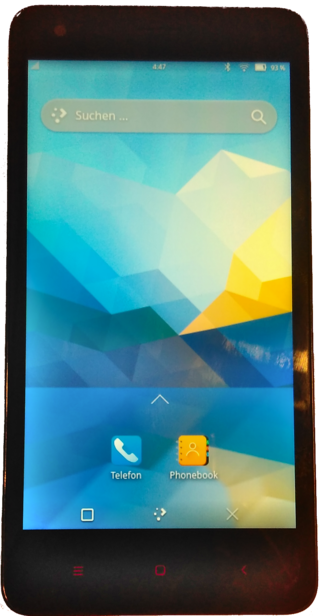
The Samsung Galaxy S series is a line of flagship Android smartphones and tablet computers produced by Samsung Electronics. In conjunction with the foldable Galaxy Z series, the lineup serves as Samsung's flagship smartphone lineup.
Xiaomi Mi2S, is a high-end, Android smartphone produced by Xiaomi. The device features a quad-core 1.7 GHz Qualcomm Snapdragon 600 as its CPU.

Redmi is a subsidiary company owned by the Chinese electronics company Xiaomi. It was first announced in July 2013 as a budget smartphone line, and became a separate sub-brand of Xiaomi in 2019 with entry-level and mid-range devices, while Xiaomi itself produces upper-range and flagship Xiaomi phones.

The Xiaomi Redmi 1 is a smartphone released in July 2013 in China And August 2013 in Global, developed by the Chinese smartphone company Xiaomi Inc. It is the first product of the Redmi series of smartphones. It came with a 4.7-inch 720x1080 IPS screen, a MediaTek MT6589T Quad-core 1.5 GHz Cortex-A7 processor and originally run Android 4.2.2 Jellybean with the MIUI v5 user interface, upgradeable to Android 4.4.2 Kitkat with the MIUI 9 user interface.

The Xiaomi Redmi 1S, code-named armani HM 1S, is a smartphone released in May 2014, developed by the Chinese company Xiaomi Inc. It is a part of the Redmi series of smartphones, and succeeded the Redmi 1. Visually similar to its predecessor, it comes with a 4.7-inch screen, a quad-core 1.6 GHz Cortex-A7 processor and runs Android version 4.3 (Jellybean), bundled with the proprietary MIUI v5 user interface, which can be upgraded to MIUI v9 based on Android 4.4.4 KTU84P.

Xiaomi Redmi 2 is a smartphone produced by Xiaomi released in January 2015. It is the successor to the Xiaomi Redmi 1 family.

The Xiaomi Redmi Note 3 is a smartphone developed by Xiaomi Inc. as part of Xiaomi's low-end Redmi smartphone line. It has three variants:

The Xiaomi Redmi Note 4 is the fourth smartphone under the Redmi Note series developed by Xiaomi Inc. It is a part of Xiaomi's budget Redmi smartphone lineup. It has two variants : The older version sold as Redmi Note 4 is powered by a Deca-core Mediatek MT6797 Helio X20 SOC. The upgraded version, sold both as Redmi Note 4X and Redmi Note 4 is powered by an Octa-core MSM8953 Qualcomm Snapdragon 625 SoC. The Redmi Note 4 was succeeded by Redmi Note 5.

Xiaomi Redmi Note 5 is a smartphone developed by Xiaomi Inc. It is a part of Xiaomi's budget Redmi Note smartphone line. Redmi Note 5 was announced on 14 February 2018 in Delhi, India, alongside the local release of the Redmi Note 5 Pro.

The Xiaomi Pocophone F1 is a smartphone developed by Xiaomi Inc, a Chinese electronics company based in Beijing. It was announced on 22 August 2018 in New Delhi, India. Though part of Xiaomi's line of mid-range devices, it is equipped with high-end specifications. The device is available globally in limited numbers, except for India where it enjoys wide availability. The Pocophone was often considered to be a flagship model of the Redmi line of 2019, although officially marketed as a separate and distinct model.
The Redmi Note 7series refer to a series of smartphones released by Redmi, a sub-brand of Xiaomi. All have 48MP + 5MP camera sensors. Most have a Qualcomm Snapdragon 660 SoC, except the Redmi Note 7 Pro, which has a better Qualcomm Snapdragon 675 SoC. The phones support mobile network frequencies in different regions. The Note 7 is available in many local versions and a global version, compatible with mobile phone providers in most places; the Pro model is supplied in slightly different Chinese and Indian versions. The Redmi Note 7S doesn't have much difference when compared to Redmi Note 7 except in case of the rear camera, hence the production of the Redmi Note 7S was discontinued and came under the Redmi Note 7 in India but it's still available separately in China and other countries.
Redmi K20 Pro and Redmi K20 are smartphones introduced by the Xiaomi sub-brand Redmi in an event held in China. A Premium variant for the Pro was later revealed, with the Snapdragon 855+, a new 512 GB/12 GB RAM model, a refined cooling system, and an exclusive finish.
The Xiaomi Mi CC9 Pro is an Android smartphone developed by Xiaomi. It is the world's first commercially available phone with a 108 MP primary camera.
Redmi K30 is a line of Android-based smartphones manufactured by Xiaomi and marketed under its Redmi sub-brand. There are two main models, the K30 and the K30 5G. A rebranded version of the K30 was later announced for India as the POCO X2, followed by the K30 5G Speed, which has a faster version of the K30 5G's chipset, and the K30i 5G which has a lower resolution camera sensor.

Redmi Note 9 is a line of Android-based smartphones as part of the Redmi Note series by Redmi, a sub-brand of Xiaomi Inc.

The Xiaomi Mi 10 and Xiaomi Mi 10 Pro are Android smartphones developed by Xiaomi Inc. announced on 13 February 2020.

Redmi K30 Pro is a line of Android-based smartphones manufactured by Xiaomi and marketed under its Redmi sub-brand. There are four models, the K30 Pro, K30 Pro Zoom, K30 Ultra and the POCO F2 Pro, which is a rebranded version of the K30 Pro.

The Xiaomi Mi 10T, Xiaomi Mi 10T Lite and Xiaomi Mi 10T Pro are Android-based smartphones developed by Xiaomi Inc. announced on 30 September 2020, while the Xiaomi Mi 10i, which is based on Mi 10T Lite but with a 64 MP camera, was announced on 5 January 2021.

The Redmi Note 10 is a line of Android-based smartphones as part of the Redmi Note series by Redmi, a sub-brand of Xiaomi Inc. This series were introduced in March 2021 in India and worldwide and May 2021 in China. It succeeds the Redmi Note 9 series of smartphones, which were introduced in 2020.














